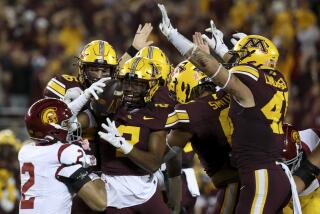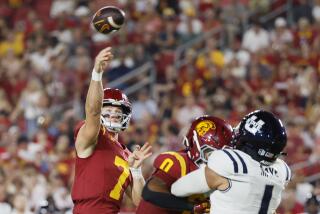Room for Improvement
- Share via
The clock ticks down to the end of the first half and the Arizona players have to be feeling good. They came into Saturday’s game at the Coliseum as heavy underdogs but trail by only a touchdown as they walk off the field and into the tunnel.
Then comes a ruckus.
The favored USC team runs up from behind, hollering, cleats banging on cement. The Arizona players turn to look, surprised, as the Trojans jostle past.
They don’t stop until they reach the top of the tunnel, pushing through a narrow door into a locker room with deep red carpeting and cubicles along the walls. In the churn of motion, all that noise, equipment guys hand out water and Gatorade, toss energy bars to anyone who is hungry. Middle linebacker Oscar Lua seeks out his position coach, Ken Norton Jr.
“Their tight end is looping around the tackle,” he says over the clamor.
Players find their way to designated spots, gathering around sketch boards. Defense by the door. Receivers in back. Kickers to the side. Reggie Bush paces in the corner with the other running backs, calling to his teammates.
“Keep your heads up,” he says. “Take this personal.”
That starts other players bellowing. A few of the assistants too.
Offensive line coach Pat Ruel kneels beside his squad, asking questions before hurrying to meet with the rest of the staff.
The top-ranked team in the nation has 15 minutes to get its act together before the second half begins.
*
Halftime has been a part of USC folklore since the team stormed back for a 55-24 victory over Notre Dame in 1974. This mystique has grown during a 27-game winning streak -- five times, the Trojans have come from behind to win after trailing at the half.
That includes last season against Stanford and Oregon State, and more recently against Oregon and Arizona State. The current Trojans have outscored their opponents, 168-42, in the third and fourth quarters.
“You have to give the credit to them,” Arizona State quarterback Sam Keller said after USC overcame an 18-point halftime deficit to win, 38-28. “They made more plays than us in the second half.”
While some have criticized the team for starting slow, the late-game turnarounds conjure images of grand strategic adjustments in the locker room. An impassioned speech or two. Knute Rockne stuff.
“Right,” linebacker Dallas Sartz says. “I’m assuming everyone expects that.”
Except it doesn’t work that way.
*
The locker room settles down after a while, players taking several minutes to themselves. Some speak quietly, others fall silent. Offensive lineman Fred Matua pulls headphones over his long, black hair and listens to Samoan music, saying: “Man, it gets me ready.”
A few voices continue jabbering, a thin choir in call-and-response.
“All day.”
“That’s the only way we know.”
“We finish. We finish.”
By now, the coaching staff has retreated to discuss strategy, offense in one room, defense in another. This would be the time for hatching great schemes, except Norton deflates that notion.
“We don’t take but three or four minutes,” the assistant explains. “There’s not a whole lot said.”
They have been chattering over headsets throughout the game, making adjustments all along, and halftime is merely a continuation of the process. Besides, if at all possible, Coach Pete Carroll prefers to avoid radical changes.
Despite his growing reputation for adjusting to the ebb and flow of each game, the coach more often talks about making hard decisions during the week, sticking to a plan come Saturday.
“I’m not going to make players try stuff they’re not prepared to do,” he says. “They wouldn’t be very good at it.”
To him, close games present an opportunity to reinforce the basics, get back to things his players have practiced since training camp. This suits his belief that athletes excel in a familiar setting.
At Arizona State, after a first half marred by penalties and misfires, Carroll simply tells his team to “start doing things right” -- and, more to the point, emphasizes the straight-ahead running portion of the game plan.
At home against Arizona, the staff spends only a few minutes going over adjustments.
As center Ryan Kalil puts it: “There’s never a big wow at halftime. We don’t pull out any special plays. We just do what we know best.”
*
You want fireworks? Screaming and threats?
Try Stanford last season, when the players openly challenged each other in an emotional scene. Or the locker room at Hawaii last month, when USC led, 21-3, halfway through the season opener.
“Coaches were on us,” defensive lineman Sedrick Ellis recalls. “It’s because, when we have big leads, we tend to get complacent.”
The Oregon and Arizona State games were tranquil by comparison. Carroll says: “The urgency is already there when we’re behind, so I need to be businesslike.”
Carroll is sensitive to criticism about his teams’ lethargic starts. It has been a point of frustration, but he insists that complacency is not to blame. If anything, he believes that players can be over-excited and mistake-prone early on.
So he vows that he will never ask them to go back out there and play the game of their lives.
“If I tell a guy that, he may be too anxious, trying too hard,” Carroll explains. “I say, ‘Don’t play the game of your lives. Just play. Just do what you’ve prepared to do.’ ”
This approach is based on what Carroll witnessed as defensive coordinator for the San Francisco 49ers, where the staff was “very directed, very technical, never relied on the emotional side of the game,” he says. Bud Grant, the former Minnesota Viking coach, was another influence.
If you don’t have anything to say, Grant once told Carroll, don’t say it.
During those few minutes when Carroll and his staff meet, they decide on a theme for the second half, an idea they can present in as few words as possible, such as the mantra at Arizona State of “doing things right.” This might sound simplistic, but football is not exactly rocket science. And the Trojans have history working in their favor, the confidence gained from all those victories, those dramatic comebacks.
*
With nine minutes remaining before the second half against Arizona, the USC assistants return to the locker room, one or two at a time, as if choreographed.
Steve Sarkisian, the assistant head coach, introduces the day’s theme, pacing before the offense, voice rising so he can be heard by everyone: “The first thing that has to happen, our tempo must increase. When that play’s over, get in the huddle. ... There’s no more walking around. Play with urgency and tempo.”
Running backs coach Todd McNair strikes a similar chord with his unit, then Carroll tears into the defense: “Let’s go take this game.”
It isn’t so much the words as the manner in which they are spoken, coaches circling fast, talking even faster, with profanity for emphasis. The team listens quietly.
Soon, the entire staff is back and working the sketch boards, diagraming plays, the room growing noisy again. Carroll gives the defense their adjustments, saying: “This is easy. We know what we’re doing.”
The truth is, the coaches like that USC amassed 321 yards in offense and surrendered only 96. But turnovers have kept the game close and Arizona will hang around through much of the second half, thanks to a long touchdown pass and a big kick return. The Trojans will have to keep up the pace for four quarters before pulling away for a victory that is closer than the 42-21 score suggests.
At halftime, there is no room for frustration or disappointment over any of this. The theme -- “Tempo” -- is repeated until it becomes contagious.
Lua springs to his feet, screaming: “Let’s go, baby.” Reserve linebacker Rey Maualuga joins in: “Yeah, let’s get it going.”
The players gravitate toward the middle of the room, hooting, jumping. Carroll bulls his way into the circle for a few words, as close to a speech as the Trojans will get.
“Let’s make sure we understand,” he says. “It happens one play at a time.”
An official stands at the door. It is time to run back onto the field.
*
(BEGIN TEXT OF INFOBOX)
Half measures
Five times in USC’s 27-game winning streak the Trojans have trailed at halftime. A look at those games -- and comebacks:
2005
OCT. 1, AT ARIZONA STATE
* Down 21-3 at halftime; won 38-28
SEPT. 24, AT OREGON
* Down 13-10 at halftime; won 45-13
2004
NOV. 6, AT OREGON STATE
* Down 13-7 at halftime; won 28-20
SEPT. 25, AT STANFORD
* Down 28-17 at halftime; won 31-28
AUG. 28, VS. VIRGINIA TECH*
* Down 10-7 at halftime; won 24-13
* -- At Landover, Md.
More to Read
Fight on! Are you a true Trojans fan?
Get our Times of Troy newsletter for USC insights, news and much more.
You may occasionally receive promotional content from the Los Angeles Times.







